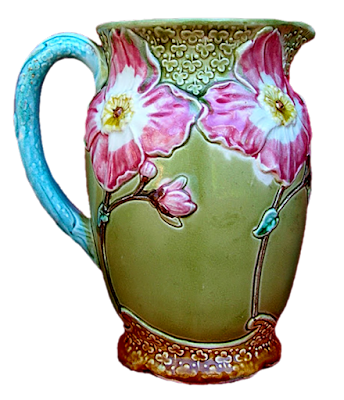The story of the majolica of Fives-Lille begins which Antione Gustave De Bruyn, a fourth generation potter from Belgium. In 1864 he left Belgium and moved to Fives-Lille, a community in the northern part of France to make his fortune in the French pottery trade.
He began by building his own factory for the production of clay pipes and whistles. Soon the business was expanded to include earthenware and stoneware for daily use. Art pottery and the newly popular majolica were incorporated into the company's catalog in 1887. Soon majolica became the body of choice for the production of humidors, jardinières, vases and umbrella stands. The company's silver medal at the Universal Exhibition in Paris in 1889, was a testament to its success.
Fives-Lille majolica policeman and thief pitcher
Soon the company was employing 300+ locals in the production of majolica, sanitary wares and art pottery. The company's large European majolica and art pottery export trade attracted the attention of designers throughout France. Among those who collaborated with the pottery were Louis Majorelle, the designer of extraordinary art nouveau furniture and Rene Lalique who was famous for his distinctive jewelry and glassware. It took the onset of WWI and a devastating fire in 1917 to cut short the company's success.
By the mid 1920's the company was back to production. It enjoyed prosperity with Art Deco pottery and ceramic clocks until the early 1930's when economic and political factors in Europe shut down the factory. Closed for the duration of WWII, the pottery opened again after the war. It was sold in 1950 and resumed limited production until 1962 when the company was dissolved.
A look at the company catalog testifies to its success in majolica. The design of their whimsical animal pitchers and Art Nouveau flower themed wares remain their most popular work with collectors. They also made limited ware in the palissy style for collectors of that genre.
The company marked their wares with both impressed marks and ink marks but always in a variation of an anchor with the De Bruyn initials. Today, majolica prices for De Bruyn majolica have remained steady which speaks quite well for their enduring appeal.






















I recently purchased a de Bruyn ceramic vase with a copper overlay and am trying to figure out more about it, specifically when it is from. Underneath the mark on the bottom is the number 264 with a 4 beneath that.
ReplyDeleteThank you for this information, very helpful in identifying it!
There is no reliable way to date the work of de Bruyn beyond stylistically. The number on the base is a catalog number relating to a mold shape. Copper overlay in general was popular during the Art Nouveau period. That would place the manufacture of your piece most likely between 1887-1900.
ReplyDeleteThis comment has been removed by a blog administrator.
ReplyDelete